New Warriors #1 (Marvel, $3.99)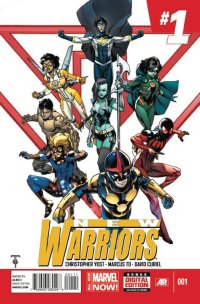
by Graig Kent
The last time we saw the New Warriors, they were the ill-fated catalyst to Marvel’s Civil War event, one of the team members blowing up part of a small town and setting off a chain reaction of events that didn’t end until “Marvel Now” kicked in a little over a year ago. With almost all other titles and characters getting fresh starts with interesting creative teams nearly line wide, it’s certainly time to bring the Warriors back, and make them “New” again.
Of course, they can’t be ALL-new, and the threads to the team’s past lie in Speedball (who mercifully has come out from under his “Penance” shadow) and Justice. The duo are looking to get back into the team heroing game (having acted as teachers and mentors for a while at Avengers Academy) and they’ve decided to set up their base of operations in New Salem, a town that acts as safe haven for all manner of magical and mystical beings (Dr. Strange is their honorary chief immigration officer). They don’t quite have a plan in mind, but after a brief scuffle with the Salem’s Seven (all spawns of Satan trying to buck any sort of ties to their lineage as the town’s protectors), they seem to have made friends and found a welcoming home.
The rest of the cast is right there on the cover, but they’re not a team, not yet. Scarlet Spider (the Peter Parker clone) and his companion Hummingbird are trying to get away from it all, permanently, in Mexico. Sun Girl, the chipper crimestopper in New York has plenty keeping her busy, while the new kid Nova faces off with an alien in Albuquerque. They all have their tussles independent of one another, but each escalates or segues into something bigger, certainly more connected, and involving the presence of the High Evolutionary. That means some cosmic-level stuff ahead, so things are going to get intense.
Christopher Yost and Marcus To, the team that doled out a tremendously solid run on DC’s Red Robin a few years back reteam here, and they haven’t missed a beat. Yost likes his scripts dense, and there’s a lot going on here, but with To on board there’s an easy flow and an immediate rhythm to the book. Just as the original New Warriors book in the 1990’s flew in the face of the grim-n-gritty trend by providing an action heavy, soap-operatic teenage hero book that recalled the heyday of Teen Titans and X-Men, so too does this New Warriors book feel lighter and less intense. It’s setting up it’s own little pocket in the Marvel U, not exclusive or completely outside of it, but also not just being seeded by an event or seeding its own.
Yost’s characterizations are great, particularly since I haven’t had much exposure to any of them beyond Speedball and Justice. On principle I dislike the Scarlet Spider, but here he’ll be an interesting personality amidst the rest of the cast. Likewise I want to dismiss this child playing cosmic cop, but Yost’s plucky Sam Alexander won me over in a brisk two pages. Though there’s big stuff brewing, some definite intensity waiting in the wings, it doesn’t feel weighty and that’s something the mainstream doesn’t produce enough of.
A longstanding favourite of mine, To’s art is once again right on point. He’s a classic artist, clean and confident lines with natural physicality, it’s an ageless style that feels like the epitome of what superheroes should look like. With To on art (and exceptional coloring from David Curiel) this book feels like “Superhero Comic” through and through. Even though I know very little of the cast, and some of them seem extremely new, I love that in To’s hands they all feel like classic characters, yet still fresh-faced.
It’s nice to see a new team book from Marvel, even a relaunch of an old one, that isn’t yet another X-Men or Avengers franchise. It seems to me that the Marvel Universe has largely been divided into those two halves, and that there’s less and less room for books to stand outside those two barely overlapping circles on the company’s venn diagram. In this respect I worry for the New Warriors’ future, but on the merits of the story and art alone I’m utterly pleased.
Rating: 




Out of a Possible 5 Stars
The Bunker #1 (Oni-Press, $3.99)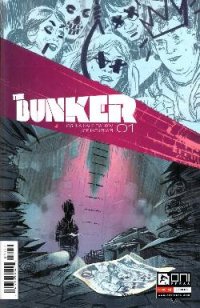
By Cat Taylor
It’s entirely possible that you’ve already heard about this comic, from writer Joshua Hale Fialkov and artist Joe Infurnari. You may even tell me that you’ve already read past the first issue and my scoop on this title is as fresh as a pair of parachute pants. If so, then allow me to confirm that I am aware this title has been in existence in digital format for some time now. However, it is brand new to the hard-copy print format and this first issue combines the first two digital issues and, I believe, some extra material as an introduction to the old-school comic book market. Therefore, this review will focus on this issue as if it were brand new to everyone.
The Bunker begins with five friends who decide to bury a time capsule before all going their separate ways for new job opportunities in other states and possibly other reasons that aren’t fully disclosed in this first issue. When they go to bury the time capsule, they instead discover a bunker from the future with their names on it. As you may surmise, the story kicks in with several mysteries quite quickly as each of the five characters finds notes addressed to them that reveal what they do in the future and urging them to change before it’s too late, or make sure it occurs, or somehow influence one of the other characters to do or not do something. If it sounds like there is a lot to keep up with this early in the series, you are correct. If that’s not enough, the story flashes forward on several occasions to follow what these five characters do in the future. I had to read the story twice and even wrote notes to myself to keep all the threads straight before writing this review. You may not need to go that far in order to keep up but this isn’t a passive reader’s superhero punch-’em-up by any means either.
As the story progresses, the friendships become extremely strained as secrets are revealed and trust is eroded. Although it seems that the information in the notes is the main cause of this, it also appears that this group doesn’t really like each other much from the beginning. There is no information about what keeps them together and their interactions before finding the bunker are wholly comprised of insults toward each other. Perhaps this is meant to come off as friendly ribbing but since there aren’t any laughs, jokes, offers of help, compliments, or friendly discussions about shared interests, it doesn’t read that way to me. It’s possible that the writer wants us to understand that these friendships were pretty much done before finding the bunker and burying the time capsule is a desperate attempt to preserve the memory of friendships that nobody is willing to acknowledge have been outgrown.
The artwork in this issue is inconsistent and should have been touched up before moving from digital to print. Joe Infurnari shows moments of brilliance where his art is reminiscent of Joe Kubert, but most of the time it looks like a bunch of storyboards and sketches of ideas that weren’t finished. Infurnari is also listed as the colorist but there isn’t a lot of color in this issue. It’s largely gray scales and the color that is included is mostly washes of light blues or other dim colors.
Although I’ve been pretty vague as to the future events for which the five characters in this story are responsible, let me assure you that this isn’t just a lot of soap opera stuff. The events are world-changing disasters that eradicate a majority of the population, involve them in high level global politics, scientific disasters, murder, and just about every kind of major action event that you could imagine. It’s risky to say this so early, but if the multiple threads don’t unravel and the stories stay exciting, I could see this comic book being a successful television series similar to what The Walking Dead became.
Rating: 




Out of a Possible 5 Stars
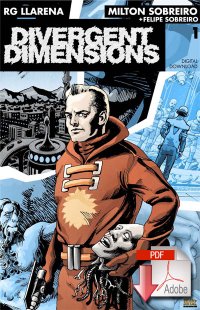 Divergent Dimensions Vol. 1 ($4.99, Heavy Metal Digital)
Divergent Dimensions Vol. 1 ($4.99, Heavy Metal Digital)
by D.S. Randlett (@dsrandlett)
The best science fiction, even the most optimistic, recognizes the constants in human nature and society. It goes without saying at this point, but sci-fi serves as a way not only to envision our future, but to push present trends to the Nth degree, to analyze and dissect the drives of individuals and society. Science Fiction has replaced the religious parable as the means by which our culture plays with its morals, as the core ideology that drives our thought and progress has irrevocably changed from a culture of tradition to one of method, no matter what Ken Ham says. Or rather, after Francis Bacon laid the groundwork for the scientific method, a new tension arose in the West between philosophies of tradition, which play on how reality feels, and philosophies of method, which play on how reality acts.
This tension is deftly illustrated in the first volume of Divergent Dimensions by writer R.G. Llarena and artists Milton and Felipe Sobreiro (creators of the excellent The Holy One), a collection of science fiction shorts by the creators that originally appeared in the pages of Heavy Metal.
Llarena’s scripts have a distinct voice, refreshing in its lack of cynicism. Not that these are bright and happy stories, mind, but for all of the revolutions waged with robot war machines, sentient idols, and cat people, each of these stories throbs with an honesty that’s missing from a lot of modern genre work. The first two stories feature divine revelations, each presented in a very different life. In one, a woman becomes a technological angel uplifting an alien species that will come to revere her as a goddess, while in another a very different kind of angel offers peace on Earth through the obliteration of selfhood. These two stories establish the thematic pattern of the collection: that religion and society aren’t so much problems as they are paradoxes. Religion offers poetry and a sense of uplift, but it also offers a sort of oblivion. Is one worth the cost of the other? Llarena’s scripts each offer different answers to this dilemma, each by turn despairing and hopeful.
Of course, there are all sorts of fun, awesome ideas on display. A religion whose infrastructure is built not around altars, but computer terminals. The aforementioned cat people. Execution by time travel. Like all great sci-fi, Divergent Dimensions is willing to spur thought while providing visions that are just fucking awesome.
These visions are brought to visual life by Milton and Felipe Sobreiro, who did great work on The Holy One. If anything, the collection of shorts gives a better idea of what this duo is capable of. The pencil work, by Milton, tends to follow a more realist bent, borrowing from classical imagery when appropriate while at the same time twisting those influences in fun and unexpected ways. The colors, by Felipe, evoke European styles, favoring a sort of watercolor look. It’s always beautiful, and goes a long way in terms of evoking the desired mood.
If you can’t get enough of the weird sci-fi presented in Prophet, you’d do well to swing by Heavy Metal Digital and pick up a copy of Divergent Dimensions. It presents a set of underexposed voices who are willing to face down their themes with honesty and creativity,two weapons that genre storytelling could use more of these days. Highly recommended.
Rating: 




Out of a Possible 5 Stars
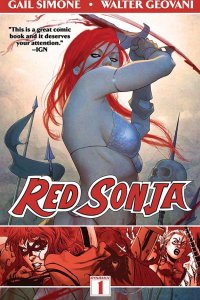 Red Sonja: Queen of Plagues #1 (Dynamite, Free on Newsarama, Volume 1: $19.99)
Red Sonja: Queen of Plagues #1 (Dynamite, Free on Newsarama, Volume 1: $19.99)
By Adam X. Smith
It’s at times like this that for all my high-minded intellectualism and even-handedness (try not to snigger) I sometimes feel like just a little bit of a phony. I’m obviously familiar with Gail Simone as a person of interest and as a writer: she coined the now-ubiquitous (but sadly not obsolete) term “women in refrigerators”, she’s written for both Marvel and DC but is most typically associated with her work on Wonder Woman, Batgirl, Birds of Prey and Secret Six. She even wrote an episode of Justice League Unlimited that counts among my favourites in a show full of classic episodes. And of course, she has a considerable and avid following on Tumblr, of which I consider myself a small part.
“Adam X. Smith you charismatic stallion,” you should all quite rightly be asking me at this point, “why, then, have you never actually read any of her comics before?”
Well, Mr and Mrs Voice-In-My-Head, the honest answer is easily the most shaming and copout-feeling one I can think of: I simply hadn’t been able to muster the interest before. It’s the same reason I still haven’t gotten round to Margaret Atwood or Ursula K. Le Guin or Jane Austen or the countless other great authors I’m supposedly missing out on: I already know they’re good – people won’t shut up about them – and since the law of averages says I can’t ever hope to read all of the books in existence, surely I should prioritise the books I actually intend to read first and work my way onward from there?
However, a couple of things prompted me to change my mind rather drastically on the subject of Ms Simone recently. Firstly, she announced that her DC series The Movement was being cancelled due to low sales*, and I found that I felt bad for not giving it a day in court when I had a chance, even though advertisement for it and its sister series The Green Team hasn’t exactly been visible from space. I mean, let’s face it, who’s going to bother reading comics about superheroes representing the dichotomy between the 99% and 1% when over a third of DC’s New 52 is dedicated to its two biggest crowd-pleasers? That’s just straight economics, yo. But I’d still summarily dismissed The Movement, intentionally or not, for what felt like an incredibly hypocritical reason – demanding innovation on the one hand and then failing to support it on the other – and now I felt (justifiably or not) the weight of responsibility for it getting cancelled.
Secondly, thanks to an article over at Newsarama (via Tumblr, naturally), I discovered that as a promotion for the trade paperback of Gail’s first Red Sonja story arc “Queen of Plagues”, they were hosting the first issue for free on the site. A free comic by a writer I’ve not got round to reading, with a character that’s kinda cool but is ripe for parody and/or deconstruction and is otherwise unfamiliar to me. Sometimes life is just too good to me.
So the book itself – well, for a start it’s well written, not that was something I was surprised by for previous reasons given. I mean, the usual swords-and-sorcery language does come off as a bit Stan Lee-ified cod Shakespearean here and there, but never so much that it took me out of the book. And the artwork by Walter Geovani reminds me distinctly of Francesco Biagini’s work on Elric: The Balance Lost for Boom! Studios**, which stands it in good stead as far as I’m concerned.
On the whole, I liked it – it wasn’t quite as original as Lazarus or as visually stunning as Captain Marvel, but credit where it’s due, I never felt it outstayed its welcome, and while the set-up did take a little longer than I thought was necessary it at least led to an actual pay-off with a surprise ending that genuinely caught me off guard – a rarity when it comes to twists and cliffhangers – and promises more electricity to come.
I really don’t want to talk about the plot because to do that would eliminate the point of this review, and that point is this: go to Newsarama. Read “Red Sonja: Queen of Plagues” #1 if you haven’t already. Maybe go out and buy the trade if you like what you see. Trust me, the first issue’s really good. And it’s free. Really, what more do you want? I saw a gap in my reading, and I decided to fill it. Go out and do likewise – maybe you’ll be pleasantly surprised, maybe you won’t.
And most importantly, don’t be one of those guys. You know the kind: the fedora-wearing, whining Men’s Rights Activist tossers who go around bitching about feminism trying to spoil all your favourite things for you but then question why Simone, noted for her feminist opinions, would possibly want to write for a comic about a woman in a chain-mail bikini – I mean, it’s obviously just man-wank material and therefore not for girls; why else would she do it other than to neuter it with P.C. hand-wringing over cleavage and the like? Seriously, take that bullshit elsewhere, folks.
The point I’m trying to make is that you may as well ask why she’d want to write for any female superhero these days, because if the M.R.A. goon squad had your way, that’s all there would be out there – a sea of disembodied tits and arses and not a single defining character trait between them, and in a world like that Gail Simone wouldn’t be able to get a mainstream job if she sat on it and twisted its arm until it cried uncle.
Good writers, even feminist ones, don’t write good female characters to push the “feminist agenda” any more than if they wrote good male characters – they do it to fill the gap in the market that no amount of comics centred on Batman or Superman or the 11 different iterations of the Justice League can fill. Whether or not I ever read another Gail Simone book, I can at least say I gave her a day in court without prejudice. And so should you.
My name is Adam X. Smith, and I just dropped all the mics.
Red Sonja: Queen of Plagues #1 Rating: 




Out of a Possible 5 Stars
*Ms Simone has stated for the record that she doesn’t blame Dan Didio for this turn of events, but as co-publisher I think it’s basically his job to be blamed for everything wrong with DC at the moment. If that’s harsh then… well, I’m not gonna say I’m sorry if that’s what you’re thinking, so yeah. Deal with it. You take the top job with the fancy office and the desk and the shiny nameplate, then you shouldn’t complain about also taking on the honourable role of being the lightning rod for criticism. Dan could really learn a thing or two from Satoru Iwata.
**On the subject of Boom! Studios, The Midas Flesh #3 continues to be fun and interesting, but on reflection not quite different enough from the previous issues to merit a full review. In the meantime…
The Midas Flesh #3 Rating: 




Out of a Possible 5 Stars
Killer of Men OGN (New Kingdom Entertainment, $8.99 through Comixology)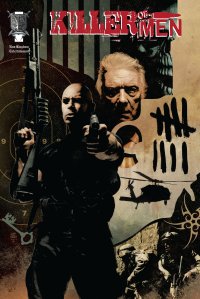
By Jeb D.
By definition, small-press comics, unburdened by the commercial/corporate expectations that plague so much of the Big 2 output, can be a great source of innovative storytelling and fresh ideas. But as with any form, there’s satisfaction to be had in seeing familiar concepts executed with care and efficiency. The Tim Bradstreet cover makes Killer of Men look like a bit of a love letter to The Punisher, and that’s pretty much what you get here: it lacks the touches of genius that a Garth Ennis can bring to such material, but if you’re looking for a capably-executed (so to speak) tale of blood and vengeance, Killer of Men will get the job done.
Our protagonist is Abriam, ex-soldier, ex-merc, now hitman, with the appropriate demons in his past. His next assignment takes him to Las Vegas, where he’s up against rival mobsters, crooked casino bosses, corrupt feds, and a motley assortment of hangers-on, turncoats, and red herrings. His path is as blood-soaked as you could ask for, but that underlines some of the book’s issues with pacing: opening with a flashback to the horrifying Iraqi encounter that turns Abriam into an avenger who seeks redemption by “only killing killers” , the next 90-plus pages continually have to up the ante: every succeeding encounter is more violent than the last, every new character is just a little bit more unlikeable than the previous one; late in the book, we meet the “ultimate” crime boss whose vileness is portrayed by his willingness to offer up the virginity of his 16-year-old daughter as a bet in a poker game, as if the reader needed to be reminded of just how bad Abriam’s targets are. Abriam’s no angel himself, of course, but that’s part of the vigilante playbook.
The story and script for this comic is the product of a small army of credited writers (James Boone, Julian Brantley, Michael Buntyn, Chris Calkins, and Alexander Storm), and the result sometimes feels less like a collaboration of like minds, than a set of compromises: while there are strong elements throughout, they rarely break out into anything unique or personally characterized; it’s as though all of the creators are so busy deferring to each other that nothing really distinctive emerges. This is particularly true of the generally on-the-nose dialog: these days, it’s nearly unavoidable to have your bad guys and bent cops repeat snarky hard-boiled pop culture clichés out of the Tarantino/Leonard thesaurus, but when our unstoppable vigilante muses things like “Emotion is a weakness. I use a mask to hide it“, we’re in serious “tell not show” territory. Similarly, the Tarantino/Ritchie style cast of hardasses and oddballs with mostly-irrelevant quirks (including a gasmasked, gimpsuited drug dealer) are an effective staple of films where actors can liven things up by imprinting their own personality on the character; on paper, though, not everyone can be Garth Ennis, who can make character quirks support the story rather than distract from it, and it’s particularly hard to emulate his approach when you’re writing by committee.
Artist Manuel Martin (with colors from Mauricio Pinzon )is a strong storyteller. As noted in past reviews, consistency in areas like perspective and anatomy tends to be one of the things that separates the top-drawer pros from those less well-known, and Martin’s work here is, for the most part, smooth and assured in those areas, rarely jarring the reader with impossible poses or wonky backgrounds. His action scenes are punchy and effective: too many artists emphasize eccentric paneling and layouts to push things along before they’ve mastered the basics; Martin seems to be getting his feet under him here, and is hopefully laying a foundation for more audacious work in the future.
If Killer of Men doesn’t break new ground in the murderous vigilante genre, it does show a promising creative team that has the basics down. I’ll be interested to see what they come up with next, though I suspect that trimming down the writing staff to a more manageable level would be a good first step.
Rating: 




Out of a Possible 5 Stars
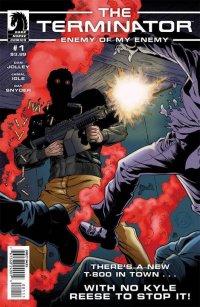 The Terminator: Enemy Of My Enemy #1 (of 6)(Dark Horse, $3.99)
The Terminator: Enemy Of My Enemy #1 (of 6)(Dark Horse, $3.99)
by Graig Kent
And here’s where I lose some of my geek cred.
I don’t care all that much for the Terminator films. Rise of the Machines was atrocious, sure, but even back in 1991, I was rather nonplussed by T2: Judgement Day and the original holds no precious space in my geek heart. I’m not a admirer of James Cameron at all, and truth told I probably enjoyed Terminator: Salvation the most of all the movies. The Sarah Connor Chronicles, actually, would be my favourite live action Terminator.
I kind of feel this way about a lot of the sacred properties of my 1980’s upbringing… Predator, Aliens (Cameron again), Robocop… there are watchable movies there, but what captures my interest about them is more the concept than what we actually see on screen. That’s why most of my cherished memories of these properties stems from the comic book extensions of them, most by Dark Horse, who revolutionized what licensed comics could be in the 1990’s.
The Terminator license has bounced around a bit over the past few years from Dark Horse to IDW to Dynamite, and back again. Dark Horse just seems like the right home for it (alongside Aliens and Predator, they built these as a holy trinity of 80’s “monsters” to rival the old Universal pantheon). They’re playing around with continuity and the Salvation thread in their other current mini-series, “The Final Battle”, while this new mini finds them back in 1985 but on a whole other tangent, one that doesn’t involve Sarah Connor or Kyle Reese.
Instead we have Farrow Greene, ex-CIA, who has faked her death, likely because of a huge bounty on her head (for as yet unknown reasons). She survives by taking sketchy jobs that require no questions asked. She’s hired to kidnap Dr. Elizabeth Wu, who herself has gone into hiding. Given Greene’s intelligence skills it doesn’t take long for her to track Wu down, but neither does it take a Terminator long to find the same target. Fight ensues, Wu takes flight and what Greene experiences as she engages this machine of a man has her reeling.
Though set in 1985, this takes me right back to 1992, having very much the same feel as the Terminator books of that time. They’re retelling the Terminator story from different perspectives while expanding and exploring the concepts at the same time. This first issue doesn’t do a lot in the expansion department, not quite yet, but it’s definitely seeded in, and you can bet that Dr. Wu has ties to Skynet in some way.
Dan Jolley is in as writer, and he provides a solid script. It’s nothing fancy, but it gets the job done capturing the feel of the Terminator without copying it whole hog. Farrow Greene has presence on the page, exceptionally fit, very stern, and hard…very, very hard. She’ll be interesting to follow, especially as she winds up as Wu’s protector, but not her salvation, and must do so watching over her own shoulder. Things are definitely poised to escalate. The Terminator here is also not quite like what we’ve seen before. When he finds clothes he dons body armor as well, and he seems to have an unusual amount of concern for his appearance. I’m not sure what to make of this yet.
Jamal Igle is a great “nothing fancy” type of artist that I’m always happy to see on a book I’m reading. He sets a stage well, with very naturalistic tendencies. His figures move like people, and he’s gifted at facial expressions (particularly in giving Greene a variety of expressions under her grim demeanor). If there’s a standout element to Igle’s work here, though, it’s the attention to the details of 1985. Padded shoulders, excessive fabric jackets and big, thick-framed glasses are just some of the subtle touches in throwing the story backwards in time.
At the moment, the book is all set up, and it hasn’t quite taken flight yet. It’s a story that will likely be better in its whole than in its parts, but Terminator fans and casual observers should find it an enjoyable one either way.
Rating: 




Out of a Possible 5 Stars
Healed #2 (Homeless, $1.99 digital format, $3.00 print format)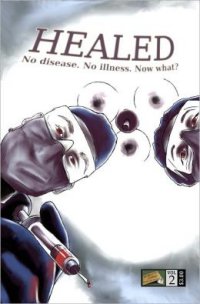
By Cat Taylor
Similar to The Bunker, Healed (from writer George W. O’Connor and artist Griffin Ess) deals with future events that have resulted in a global disaster. However, rather than a disaster that eradicates a large part of the world’s population, the opposite has occurred. All sickness, disease, viruses, etc. have been completely eradicated. Everyone on the planet is practically immortal from death by “natural causes” and can only be killed by violent acts. While this scenario is ideally what the world’s scientific community is always shooting for, Healed jumps right in with the majority of the population freaking out within 72 hours of finding out that there is no more disease in the world. Realistically, I would expect people to be elated for a few years before truly understanding the negative consequences of practically living forever. O’Connor instead takes the view that the populace would be immediately panicked and portrays them doing things like committing suicide, murdering, and looting out of desperation. Some of this is explained as a lot of people not really having a full grasp of the news about a cure for death. As a result, many of the people believe this means their bodies are impervious to physical harm from things like bullets, leaping out of buildings, and car crashes, which is not the case.
Although this is the second issue of the comic, there is no clear protagonist so far. Of the three main characters that are introduced, one dies before the end of this issue, one is a high-level federal government official who is proposing genocide of the homeless, disabled, and mentally ill to control the population, and one is Vanessa, the CEO of a medical corporation that has become obsolete due to medicine no longer being needed. Consequently, she is portrayed as a selfish, one-dimensional evil bitch, for lack of a better description. It is unlikely that any of these characters are going to be the protagonist that the reader will want to follow and root for from week-to-week. This is an unusual approach for a story and a risky one that to my knowledge has never succeeded. Even in the case of anti-heroes, there are enough redeeming qualities for most readers to enjoy them. Frankly, I don’t see redeeming qualities in any of these characters. The only other possibility for a protagonist out of this bunch is a nebbish assistant to Vanessa named Anthony who only served a sounding board for Vanessa’s exposition in this issue. There could be plans to develop him but so far he looks like a pretty weak option for a reader’s surrogate.
While I like the premise of this comic and think the story has a lot of potential to answer questions about the consequences of practically living forever, I wish I could say the same for the art. The artist has a style that looks less like the work in a narrative graphic novel, and more like the amateurish one-panel comics in a student newspaper. The drawings are a bunch of roughly sketched, black and white images with no attention to form or dimension. It looks like the lazy work of someone who drew as quickly as possible to just get some ideas on a page, ran a few fast ink washes over the work for shading, and called it quits. It’s really disappointing to see this kind of work on a story with this much potential.
Since I don’t want to end the review on a bad note, first I want to point out that this comic is another piece of indie work that is being largely funded by Kickstarter, and that type of self-made success deserves recognition. Second, when I choose to review an independent comic, I do so because there is something unique and captivating about the book. In this case, Healed is tackling an issue that could become reality someday as medical science becomes more advanced. What seems like a good thing can be a disaster if the world isn’t ready to handle the inevitable side effects of the situation. Healed is the first comic book I’ve seen to take on this issue in a thoughtful way and has the potential to take this concept even further.
Rating: 




Out of a Possible 5 Stars